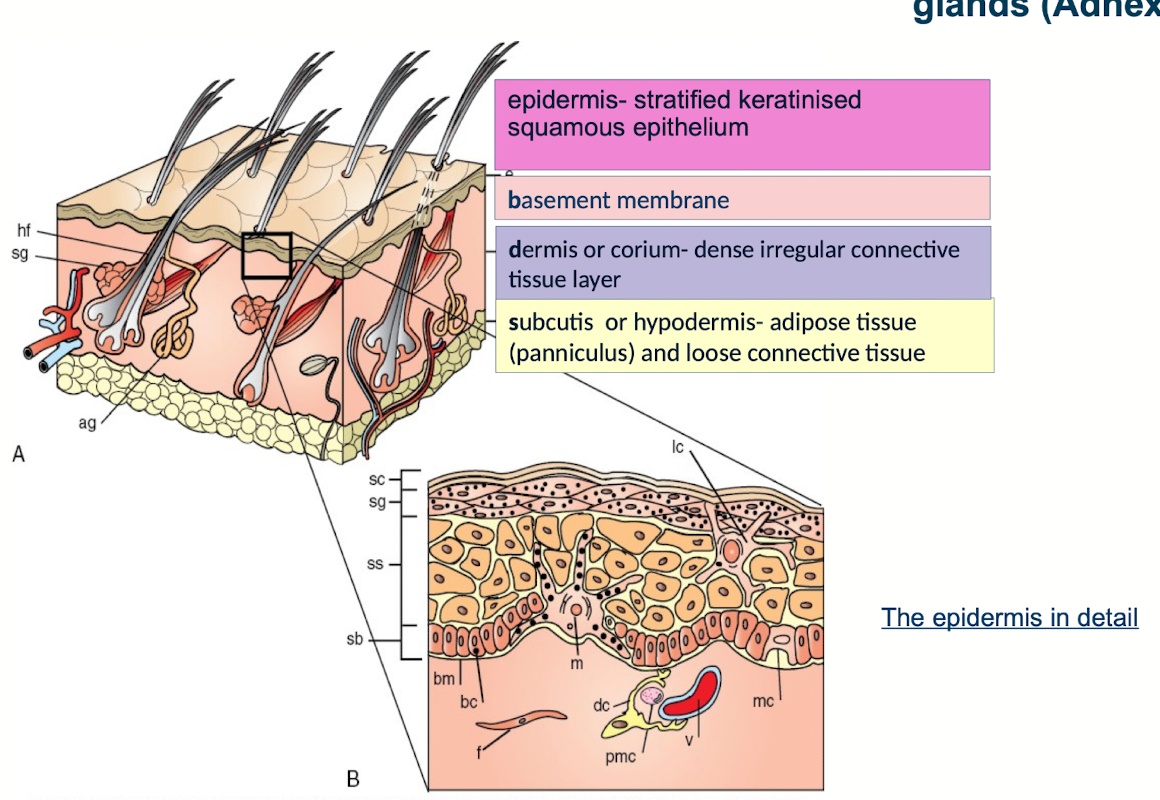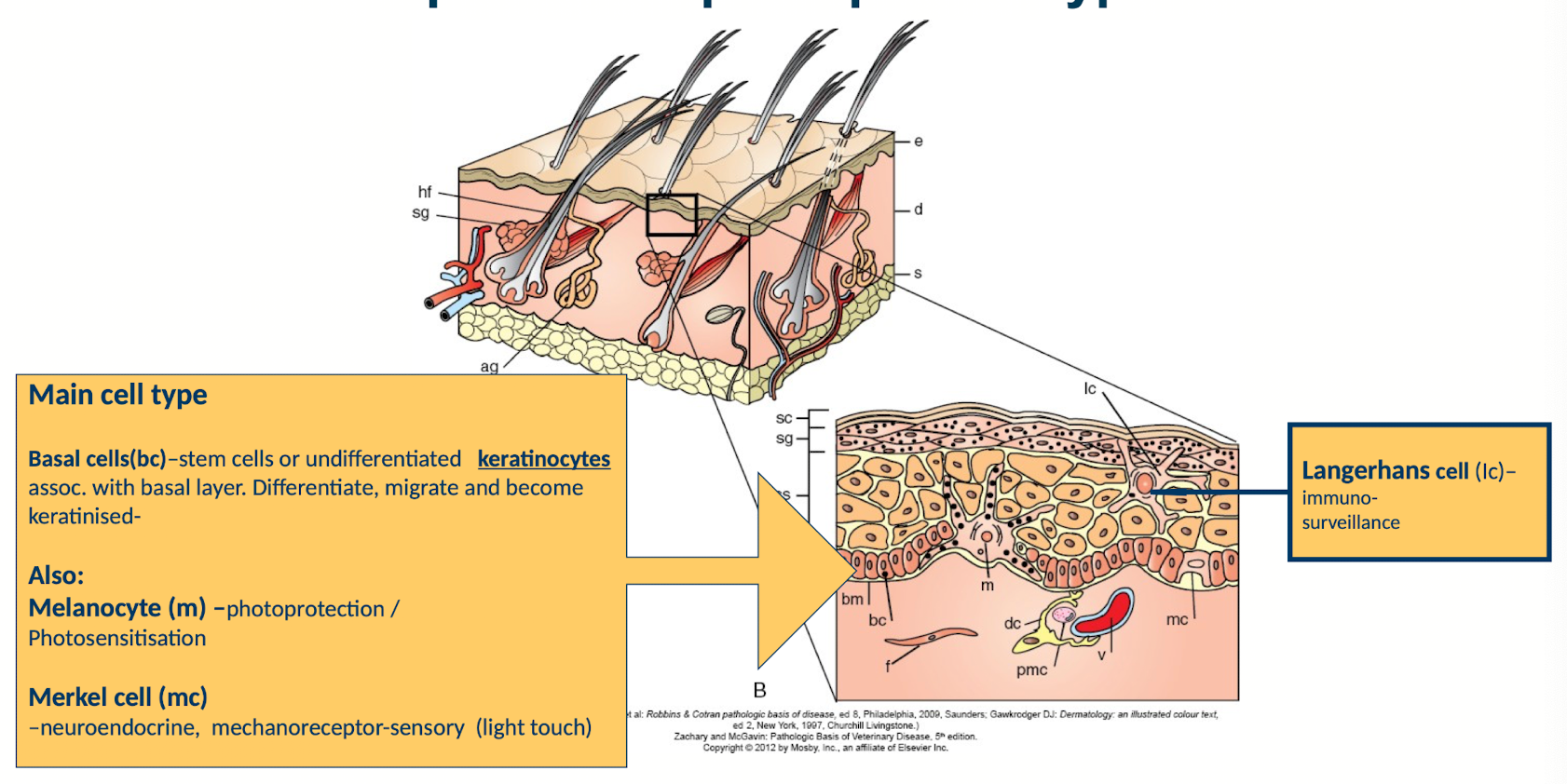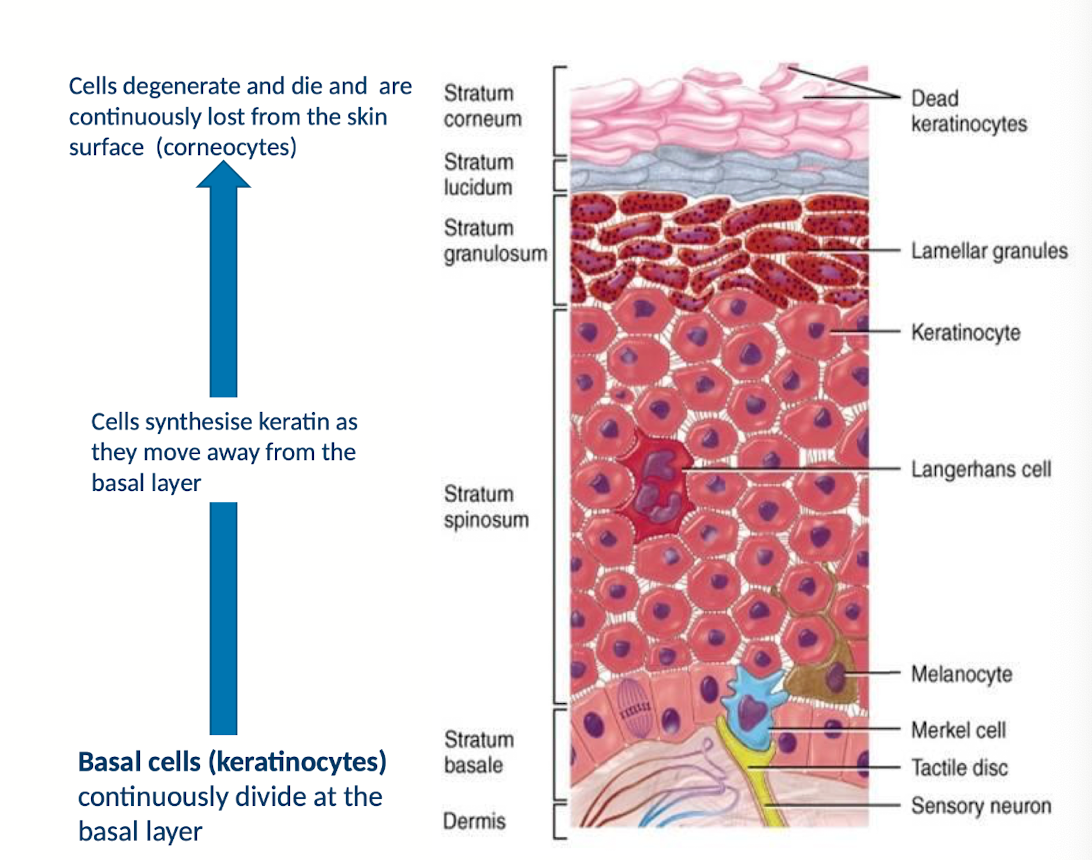The Integument 1 (Epidermis, Dermis & Hypodermis)
1/29
There's no tags or description
Looks like no tags are added yet.
Name | Mastery | Learn | Test | Matching | Spaced |
|---|
No study sessions yet.
30 Terms
What is the one of the largest organs of the body?
The common integument
What structures does the common integument contain?
Skin
Hair and a variety of skin associated glands (adnexa)
Claws, hoofs, feathers and horns
How can the integument be defined?
A structure which completely encloses the body, allows motion whilst retaining shape and defines individual identity
What are the key functions of the integument?
• Protective -wear and tear
• Barrier- microbial penetration/ impermeable to water
• Thermoregulation
• Sensory perception
• Storage organ - adipose tissue (hypodermis specifically)
• Synthesis Vit D3
• Glandular - sebum and sweat secretions
• Photo-protection/ sensitisation
• Immuno-surveillance
• Capture of prey.....
Histologically speaking, what does the skin consist of?
Describe layers from outermost to innermost and what they contain.
Epidermis
stratified keratinized squamous epithelium
Basement membrane
Dermis or corium
dense irregular connective tissue layer
Hypodermis or subcutis
adipose tissue (panniculus) and loose connective tissue
Adnexa: **Everything else: also contains hair follicles (Simple or compound) and skin associated glands (sebaceous glands, sweat glands (apocrine or eccrine)).

What is the clinical importance of the integument?
Many exogenous and endogenous factors may influence condition of the skin
Economic significance in food producing animals
Allergies, dermatitis and parasitic infection in companion animals
Skin incised in almost all surgical procedures
Describe some exogenous and endogenous factors impacting the condition of the skin.
Exogenous
Nutritional, microbial, chemical, physical, parasitic, allergic
Endogenous
Immunologic, congenital, hereditary, hormonal, emotional, metabolic, age, internal disease
Describe the embryological development of the skin.
• Primitive Epidermis is of ectodermal origin
Dermis is of mesodermal origin
• Basal cells undergo proliferation, migration and differentiation resulting in cell death
• Stratified keratinised squamous epithelium - forms a physical and permeability barrier
• Melanocytes from neural crest origin migrate to the dermal-epidermal border. Responsible for pigmentation of the skin
What are the principal cell types of the epidermis?
Main cell type
Basal cells(bc) -stem cells or undifferentiated keratinocytes assoc. with basal layer. Differentiate, migrate and become keratinised-
Also:
Melanocyte (m) - photoprotection / Photosensitisation by forming umbrellas over the basal cells to protect the nuclear contents from affects of UV light
Merkel cell (mc) -neuroendocrine, mechanoreceptor-sensory (light touch sensations and sends signal to surrounding nerve endings)
Langerhans cell (lc)

What cells play an immuno-surveillance role in the epidermis
Langerhans cells
What does strata mean and where are they recognized?
Strata - refers to the 5 layers of the skin
Most obvious in thick hairless skin
The epidermis is composed of different ____.
From outer to inner surface, describe the different strata layers.
Strata
Stratum Corneum
Stratum Lucidum
Stratum Granulosum
Stratum Spinosum
Stratum Basale
Describe the process of keratinization and how the cells divide.
Basal cells (also known as keratinocytes) continuously divide at the basal layer
Cells synthesize keratin as they move away from the basal layer
Cells degenerate and die and are continiously lost from the skin surface (corneocytes), top surface composed of dead keratinocytes

What is keratinization?
Is the process that results in the protective and waterproof layer on the surface of the skin and other waterproof tissues
What occurs in the stratum basale or basal layer of the skin? What cells are found there?
Basal stem cells (undifferentiated keratinocytes)- mitotically active layer where cells divide and move outwards
Tonofilaments appear in the cytoplasm
What are tonofilaments?
Tonofilaments are bundles of keratin intermediate filaments within epithelial cells that provide structural support and anchor the cell's cytoskeleton to cell junctions like desmosomes
What occurs in the stratum spinosum region of the skin? What cells are found there?
Stratum spinosum = several layers thick of polyhedral cells with spiny projections due to shrinkage of cells
Active synthesis of keratins within cytoplasm occurs
Tonofilaments increase in quantities
Lamellar bodies appear in cytoplasm - organelles containing lipid which are extruded as cells enter the St. granulosum
Cells become progressively flattened
What occurs in the layer of the skin progressing from stratum granulosum to stratum corneum?
Nucleus and organelles start to break down
Keratohyalin granules appear - which contain precursor proteins of filaggrin and loricrin
What process does filaggrin contribute to?
A protein which causes tonofilaments to aggregate and form tonofibrils, contributing to keratin protein formation
What process does loricrin and involucrin contribute to?
two proteins which contribute to the formation of a protective and thickened cell envelope
What important role do lamellar bodies have?
these structures release lipids between cells, playing an important role in waterproofing.
What cell junctions rivet dead squames together and where is this absent? What is the absence of these special cell junctions called?
Desmosomes (Corneodesmosomes)
Absent in outermost layer - desquamation
What does the control of desquamation at the surface of skin depend on?
• Balance between levels of protease inhibitors & proteases (latter cause enzymatic degeneration of desomsomes junctional complexes which anchor the cells to the surface)
What controls the rate of keratinization and proliferation?
• Fibronectin in basement regulates rate of keratinization
• Epidermal growth factor stimulates proliferation of keratinocytes
What important factors does the skin pH control?
Barrier homeostasis, stratum corneum integrity, cohesion, desquamation and in antimicrobial defence
Where are most sweat glands found? How about sweat glands and hair follicles?
Eccrine sweat glands are often present in the dermis, sebaceous as well
Hair follicles also in dermis
Describe key histological features of the dermis or corium regarding:
Cell types
Fibers
Ground Substance
Cell type
fibroblasts, mast cells, plasma cells, macrophages, adipocytes, melanocytes, lymphocytes, neutrophils
Fibers
Different types and proportions, collagen, reticular and elastic fibers
Ground Substance
Dense fluid (proteoglycans and glycoprotein)
REMINDER: What do fibroblasts produce?
fibroblasts produce/maintain the extracellular matrix
The blood supply to the skin is located in the ____.
dermis
How is blood supplied to the epidermis?
What type of anastomsis here is important for thermoregulation.
Epidermis is nourished by diffusion from blood vessels located in the dermis, they do not penetrate into the epidermis
Arterio-venous anastmosis in the dermis are common and important for thermoregulation
Controlling whether blood gets closer to the surface or is retained underneath